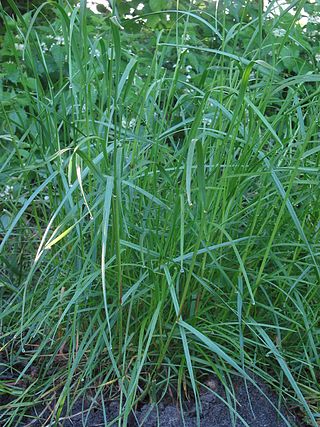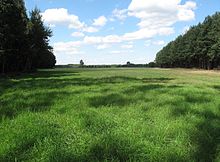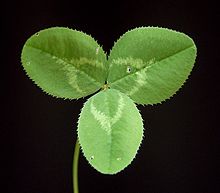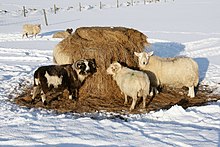
Vicia sativa, known as the common vetch, garden vetch, tare or simply vetch, is a nitrogen-fixing leguminous plant in the family Fabaceae. It is now naturalised throughout throughout the world occurring on every continent, except antarctica and the arctic. The centre of diversity is thought to be the Fertile Crescent, although gold standard molecular confirmation is currently not available.

A legume is a plant in the family Fabaceae, or the fruit or seed of such a plant. When used as a dry grain, the seed is also called a pulse. Legumes are grown agriculturally, primarily for human consumption, for livestock forage and silage, and as soil-enhancing green manure. Well-known legumes include beans, soybeans, chickpeas, peanuts, lentils, lupins, grass peas, mesquite, carob, tamarind, alfalfa, and clover. Legumes produce a botanically unique type of fruit – a simple dry fruit that develops from a simple carpel and usually dehisces on two sides.

Trifolium repens, the white clover, is a herbaceous perennial plant in the bean family Fabaceae. It is native to Europe, including the British Isles, and central Asia and is one of the most widely cultivated types of clover. It has been widely introduced worldwide as a forage crop, and is now also common in most grassy areas of North America, Australia and New Zealand. The species includes varieties often classed as small, intermediate and large, according to height, which reflects petiole length. The term 'white clover' is applied to the species in general, 'Dutch clover' is often applied to intermediate varieties, and 'ladino clover' is applied to large varieties.

Festuca (fescue) is a genus of flowering plants belonging to the grass family Poaceae. They are evergreen or herbaceous perennial tufted grasses with a height range of 10–200 cm (4–79 in) and a cosmopolitan distribution, occurring on every continent except Antarctica. The genus is closely related to ryegrass (Lolium), and recent evidence from phylogenetic studies using DNA sequencing of plant mitochondrial DNA shows that the genus lacks monophyly. As a result, plant taxonomists have moved several species, including the forage grasses tall fescue and meadow fescue, from the genus Festuca into the genus Lolium, or alternatively into the segregate genus Schedonorus.

In agriculture, a living mulch is a cover crop interplanted or undersown with a main crop, and intended to serve the purposes of a mulch, such as weed suppression and regulation of soil temperature. Living mulches grow for a long time with the main crops, whereas cover crops are incorporated into the soil or killed with herbicides.

Lolium perenne, common name perennial ryegrass, English ryegrass, winter ryegrass, or ray grass, is a grass from the family Poaceae. It is native to Europe, Asia and northern Africa, but is widely cultivated and naturalised around the world.

Festuca pratensis, the meadow fescue, is a perennial species of grass, which is often used as an ornamental grass in gardens, and is also an important forage crop.
British NVC community MC10 is one of the maritime cliff communities in the British National Vegetation Classification system. It is one of five communities categorised as maritime sea-cliff grasslands.
British NVC community MG5 is one of the mesotrophic grassland communities in the British National Vegetation Classification system. It is one of four such communities associated with well-drained permanent pastures and meadows.
British NVC community MG6 is one of the mesotrophic grassland communities in the British National Vegetation Classification system. It is one of four such communities associated with well-drained permanent pastures and meadows.
British NVC community MG4 is one of the mesotrophic grassland communities in the British National Vegetation Classification system. It is one of four such communities associated with well-drained permanent pastures and meadows.
British NVC community MC5 is one of the maritime cliff communities in the British National Vegetation Classification system. It is one of five communities categorised as maritime cliff crevice and ledge communities.

Festuca arundinacea (syn., Schedonorus arundinaceus and Lolium arundinaceum) is a species of grass commonly known as tall fescue. It is a cool-season perennial C3 species of bunchgrass native to Europe. It is an important forage grass throughout Europe, and many cultivars have been used in agriculture. It is also an ornamental grass in gardens, and a phytoremediation plant.

Gavojdia is a commune in Timiș County, Romania. It is composed of four villages: Gavojdia, Jena, Lugojel and Sălbăgel.
The Legume Information System (LIS) is legume sciences portal specifically for legume breeders and researchers, established and supported by the Agricultural Research Service of the United States Department of Agriculture. The mission of the Legume Information System is "to facilitate discoveries and crop improvement in the legumes," in particular to improve crop yields, their nutritional value, and our understanding of basic legume science.
Bela "Bert" Grof was a Hungarian-born Australian agricultural researcher with contributions to grassland and forage research in the tropics.
Sown biodiverse pastures consist of diverse mixes of up to twenty different species or varieties of seeds, and are rich in legumes. They are more productive than natural grasslands, and are also richer in number of species. The seed mix is designed specifically for each location after soil analysis. Species in the mix is adapted to soil physical and chemical characteristics, as well as to local climate conditions, and therefore there is no single representative mix. However, some very common sown species in SBP are Trifolium subterraneum, Trifolium incarnatum, Trifolium resupinatum, Ornithopus spp., Biserrula pelecinus, annual Medicago spp., and grass species of the genera Lolium, Dactylis and Phalaris. The mixes of sown species are often enriched with seeds from spontaneous plants such as Plantago spp., Vulpia spp. and Bromus spp.. Legumes are thus very common in these mixtures and cover more than 50% of first-year SBP. As pasture settlement progresses, legumes increase and eventually dominate. Percentage of legumes in the plant cover of a mature SBP is around 25–30%. Legumes are inoculated with bacteria of the genus Rhizobium which induce nitrogen-fixing nodules in the roots of legumes. The fixated atmospheric nitrogen is then used by grasses thus making the overall system self-sufficient in terms of nitrogen.















